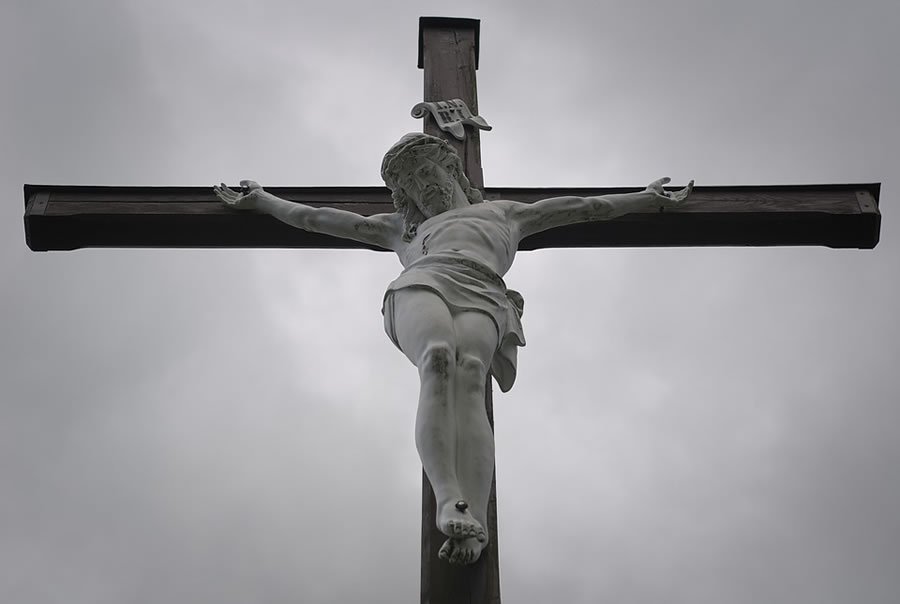
Reflecting Heaven Part 16: The Stations of the Cross
08-11-2021Reflecting HeavenFr. Don Kline, V.F.Each Friday during Lent, many in our parish, and around the world, gather to trace the footsteps of Jesus on his Via Dolorosa (Sorrowful Way), the Way of the Cross, or Via Crucis. I have been deeply moved and inspired at St. Bernadette over the years by all those who have prayed the Stations of the Cross.
The Stations of the Cross are just that – “stations” on a journey. Praying the Stations of the Cross involves movement – walking with Jesus – from one place to another, at least by the leaders if the space does not accommodate the whole group’s moving. Anyone who’s prayed an Way of the Cross in Jerusalem has experienced this first hand; the journey from place to place is a powerful microcosm of the Christian pilgrim’s life, journeying with Jesus.
But what are the Stations of the Cross, exactly? Where do they come from? The Way of the Cross originated in Jerusalem early in the Christian era and grew in popularity during the middle ages, when European crusaders would retrace the footsteps of Jesus from His sentencing by Pilate at the Praetorium to the hill of Calvary, where Our Lord was crucified.
Ultimately, they grew from the early tradition that the Blessed Virgin Mary followed Jesus on his Via Dolorosa and then retraced the steps each day after His ascension into heaven. This is why, by the way, the hymn most commonly associated with the Stations is the Stabat Mater (At the Cross Her Station Keeping), reflecting on Mary’s sorrow as She walks with Her Son as He carries His cross.
Eventually the Franciscan order became the official keepers of the Via Crucis, and they not only cared for the Way in Jerusalem, but also promoted the spread of the devotion throughout Europe by placing a series of wooden crosses in parish churches. Those Christians who could not make a full pilgrimage to Jerusalem could at least trace the footsteps of Jesus in their own parish church through the stations. The number of stations varied until it was fixed at fourteen by Pope Clement XII in 1731.
As far as I know, there is no official Church legislation dictating that Stations of the Cross must be included in every church, but have you ever seen a Catholic church without them? An interesting note is that, whatever the artwork of the stations, each one must include a cross. And it is that cross, not the artwork surrounding it, that comprises the actual “station.”
So what about our stations at St. Bernadette? First of all, why update our current ones? The answer to that is similar to the answer to why we’re getting new stained glass windows. The current stations are not bad, (actually they are quite beautiful) but they are a bit small for the large space on the wall. So the artists and sculptors went to work to find a way to keep the current stations while enabling them to fit the space in a more proportional way.
Our updated stations, are the same colorful stations but they are now ensconced in a new beautiful frame that will closely resemble the frame currently around both Our Lady and St. Joseph - marble columns and all!
Images depicted in the Stations of the Cross provide powerful reminders of the depth of Our Lord’s love for us. There is no limit to the reach of God’s love. No one is beyond the grasp of God’s mercy. Images found along the Via Dolorosa are there to remind us of Christ’s willingness to suffer for our salvation. Meditating on the depth of God’s love and mercy provides us with many blessings and graces.
One blessings people often find in this devotion includes the strength God provides to carry our own cross. As we pray the Stations of the Cross and reflect on the those present at the foot of the cross you may be encouraged to know that you are not alone in your suffering. Perhaps you think of Mother Mary and the disciple John faithfully present before Our Lord on the Cross. Maybe the women Our Lord comforts along the way come to mind for you. One can also include the centurion Longinus often depicted at the foot of the cross. He is traditionally known as the Roman centurion who pierces Jesus’ side with a lance and later becomes Christian by virtue of his experience with Our Lord. There are other recurring characters along the Way and more levels of symbolism to explore that can provide great depth and richness to those who pray the Stations of the Cross.
As with all quality sacred art, there is always more to discover each time we contemplate it - certainly a fertile field of reflection and prayer each time we walk the Stations.
It is my hope as you reflect on these words, you will come to see that sacred art is very different. While it is often inspiring, powerful and often beautiful - sacred art can also be disturbing, challenging, and painful. However Our Lord moves your heart, if you enter into it, sacred art can change you and move you closer to God. Quality sacred art reaches into a person’s core and can bring their heart and mind truths that would never sink in if presented prosaically. So may it be when we pray these Stations of Our Lord’s Cross. By contemplating them, may we be drawn closer into relationship with Jesus Christ; may we be changed from the inside out as we make our journey with Our Lord!
BACK TO LIST